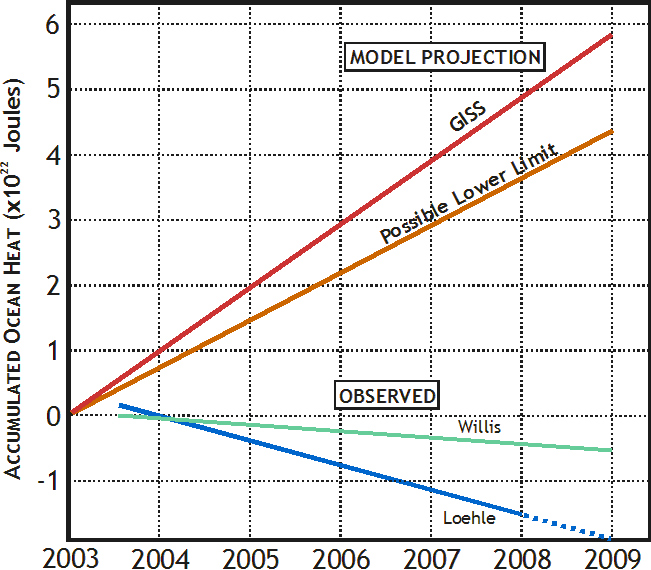Contributed by: filbert Thursday, May 07 2009 @ 08:22 AM CST
 |
Albert Einstein once said, “No amount of experimentation can ever prove me right; a single experiment can prove me wrong.” Einstein’s words express a foundational principle of science intoned by the logician, Karl Popper: Falsifiability. In order to verify a hypothesis there must be a test by which it can be proved false. A thousand observations may appear to verify a hypothesis, but one critical failure could result in its demise. The history of science is littered with such examples.
. . .
Writing in 2005, Hansen, Willis, Schmidt et al. suggested that GISS model projections had been verified by a solid decade of increasing ocean heat (1993 to 2003). This was regarded as further confirmation the IPCC’s AGW (anthropogenic global warming) hypothesis. Their expectation was that the earth’s climate system would continue accumulating heat more or less monotonically. Now that heat accumulation has stopped (and perhaps even reversed), the tables have turned. The same criteria used to support their hypothesis, is now being used to falsify it.
It is evident that the AGW hypothesis, as it now stands, is either false or fundamentally inadequate. One may argue that projections for global warming are measured in decades rather than months or years, so not enough time has elapsed to falsify this hypothesis. This would be true if it were not for the enormous deficit of heat we have observed. In other words, no matter how much time has elapsed, if a projection misses its target by such a large magnitude (6x to 8x), we can safely assume that it is either false or seriously flawed.
Assuming the hypothesis is not false, its proponents must now address the failure to skillfully project heat accumulation. Theories pass through stages of development as they are tested against observations. It is possible that the AGW hypothesis is not false, but merely oversimplified. Nevertheless, any refinements must include causal mechanisms which are testable and falsifiable. Arm waiving and ad hoc explanations (such as large margins of error) are not sufficient.
Let me translate from the cautious scientific jargon above into more easily understandable language: This means that EVERY scientific study, and EVERY policy prescription based on the GISS model of climatology is wrong. Invalid. Mistaken.
This means that James Hansen, the NASA-employed climate change fanatic who is responsible for the GISS model, is a-scientific to continue to insist that his model correctly represents reality. It does not. He is wrong. There are two types of computer models: those which accurately represent aspects of reality, and those that don’t. Those that do are, within limits, useful tools to predict future occurences and events. Those that don’t are useless fantasies. The GISS model has now been shown to reside in the latter category, along with the “Earth is Flat” model and the “Sun moves around the Earth” model.
Back to the drawing board, climate change alarmists.
